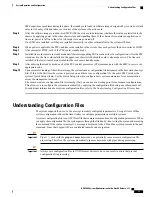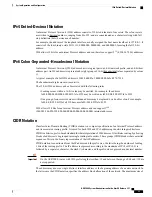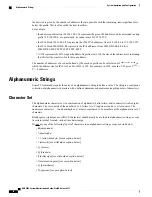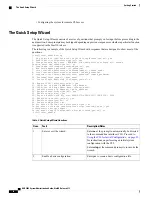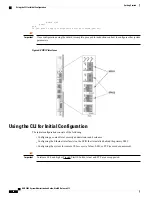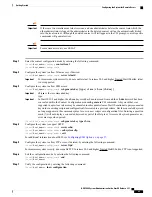
SMC experiences problems during this phase, the standby card loads its software image designated by its own boot stack
entry in its boot.sys file and takes over control of the system as the active card.
Step 5
After the software image is loaded into SMC RAM, the active card determines whether other cards are installed in the
chassis by applying power to the other chassis slots and signalling them. If the chassis slot contains an application or
line card, power is left on to that slot. All empty slots are powered off.
If no SMCs are installed, or if they are installed incorrectly, no other card installed in the system will boot.
Step 6
When power is applied to the PSCs and line cards installed in the system, they each perform their own series of POSTs.
Step 7
After successful POST, each of the PSCs enter standby mode.
Step 8
Installed line cards remain in steady mode until their corresponding PSC is made active via configuration. After the PSC
is made active, the line card installed in the upper-rear chassis slot behind the card is also made active. The line card
installed in the lower-rear chassis slot behind the card enters standby mode.
Step 9
After entering the standby mode, each of the PSC control processors (CPs) communicate with the SMC to receive the
appropriate code.
Step 10
Upon successful loading of the software image, the system loads a configuration file designated in the boot stack (boot.sys
file). If this is the first time the system is powered on and there is no configuration file, the active SMC invokes the
system's Quick Setup wizard. Use the Quick Setup wizard to configure basic system parameters for communication
across the management network.
The wizard creates a configuration file (system.cfg) that you can use as a starting point for subsequent configurations.
This allows you to configure the system automatically by applying the configuration file during any subsequent boot.
For additional information about system configuration files, refer to the
Understanding Configuration Files
section.
Understanding Configuration Files
The system supports the use of a file or script to modify configurable parameters. Using a file for offline
system configuration reduces the time it takes to configure parameters on multiple systems.
A system configuration file is an ASCII text file that contains commands and configuration parameters. When
you apply the configuration file, the system parses through the file line-by-line, testing the syntax and executing
the command. If the syntax is incorrect, a message is displayed to the CLI and the system proceeds to the next
command. Lines that begin with # are considered remarks and are ignored.
Pipes ( | ), used with the
grep
and
more
keywords, can potentially cause errors in configuration file
processing. Therefore, the system automatically ignores keywords with pipes during processing.
Important
Always save configuration files in UNIX format. Failure to do so can result in errors that prevent
configuration file processing.
Important
ASR 5000 System Administration Guide, StarOS Release 21.1
11
System Operation and Configuration
Understanding Configuration Files
Summary of Contents for ASR 5000
Page 26: ...ASR 5000 System Administration Guide StarOS Release 21 1 xxvi Contents ...
Page 316: ...ASR 5000 System Administration Guide StarOS Release 21 1 288 VLANs VLAN Related CLI Commands ...
Page 400: ...ASR 5000 System Administration Guide StarOS Release 21 1 372 Engineering Rules ECMP Groups ...















